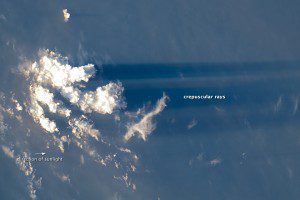The shadowed areas bounding the crepuscular rays in this image are formed by clouds or mountain tops that block the path of sunlight or moonlight. However, obstructions alone aren't sufficient to create crepuscular rays. The light also must be scattered by additional phenomena, including airborne dust, aerosols, water droplets and molecules of air, providing a visible contrast between shadowed and illuminated parts of the sky.
When observed from the ground, crepuscular rays appear to radiate outward from the source of light due to the effects of distance and perspective. However, the rays actually are parallel. This astronaut photograph from the International Space Station (ISS) provides an unusual viewing perspective from above the rays and a clear illustration of their parallel nature.
The sun was setting to the west (image left) on the Indian subcontinent, and cumulonimbus cloud towers provided the shadowing obstructions. The rays are being projected onto a layer of haze below the clouds.
To learn more about crepuscular rays, click here.
This astronaut photo was acquired on Oct. 18, 2011, with a Nikon D2Xs digital camera using a 110mm lens, and is provided by the ISS Crew Earth Observations experiment and Image Science & Analysis Laboratory, Johnson Space Center. The image was taken by the Expedition 29 crew.
Caption by William L. Stefanov, Jacobs/ESCG at NASA-JSC
Instrument: ISS – Digital Camera


